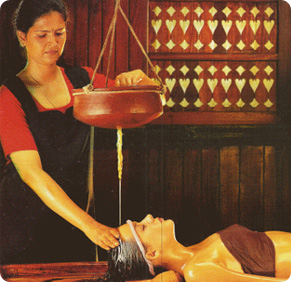Panchakarma Treatment

Ayurveda emphasizes preventative and healing therapies, along with myriad methods of purification and rejuvenation of the body, mind and soul. Apart from being a healing system, it is a science that tells us the art of appropriate living. It tells us how to achieve longevity and live a life that is free of diseases. Panchakarma is Ayurveda's one of the ancient and important purification and detoxification treatments. In Sanskrit, the word 'Panchakarma literally means "five therapies", which suggests that it is a comprehensive system of knowledge and practices to purify the body of toxins and restore it to balance with the law of Mother Nature.
The five therapeutic means of eliminating toxins from the body, which constitute the Panchakarma, are Vamana, Virechana, Nasya, Basti and Raktamoskshana. The therapies deal with stress related problems and the toxins that may trigger an ailment, at the same time, they concentrate on creating a balance between the doshas (energies that govern all biological functions). Although Panchakarma is a highly effective therapy, it can remain ineffective, if the person doesn't follow a special detoxification diet, along with the treatments. In this section, we have provided comprehensive information on Panchakarma therapy and its significance in Ayurveda.
Purification Therapy Basti Karma
One of the main procedures of Panchakarma Chikitsa, Basti karma concentrates on the elimination of the loosened vata dosha out through the rectum. The treatment involves the introduction of medicinal substances, such as, herbal oils and decoctions in a liquid medium, into the rectum of the person. This is because vata is predominantly located in the colon and bones.
Nasya Karma
One of the Panchakarmas mentioned in Ayurveda, Nasya therapy is a process wherein the drug (herbalized oils and liquid medicines) is administered through the nostrils. Since nose is the gateway of the head, the therapy is highly effective in curing a number of diseases pertaining to the head, if it is performed systematically.
Raktamoksha Therapy (Blood Letting)
Raktamoksha therapy is one of the Panchakarmas of Ayurveda. Literally meaning Blood Letting, Raktamoksha is performed to eliminate the toxins from the bloodstream through the gastrointestinal tract. It is a safe, painless and highly effective form of Panchakarma. Raktamoksha entails the refinement of blood, hence administered to treat disorders pertaining to skin, such as urticaria, rash, eczema, acne, scabies, leucoderma, chronic itching and hives.
Vamana Therapy
The kapha toxins accumulated in the body and the respiratory tract are effectively removed by Vamana, one of the five therapies of Panchakarma in Ayurveda. Vamana is therapeutic vomiting, which is a medicated emesis therapy. People with high imbalance of kapha are given this type of treatment, which loosens and mobilizes the toxins, in an effort to eliminate them from the body.
Virechana Therapy
Ayurveda, the science of life, emphasizes on the adoption of a number of preventative and healing therapies, which can purify and rejuvenate the body, mind and soul. The medicinal form of science is not just a healing system, but also an art of appropriate, healthy and disease-free living. It aims at increasing the longevity of people of all ages. | |
Other Categories
Ayurveda Concepts
Nidan
Ayurvedic Approach to Healthy Life
Kaumarbhrutya
Ayurveda Diet
Ayurvedic Herbology
Prasuti Tantra
Principles of Ayurveda
Ashtang Ayurveda
Panchakarma Treatment
Prakruti and Vikruti
Dincharya
Ayurveda Basics
|

